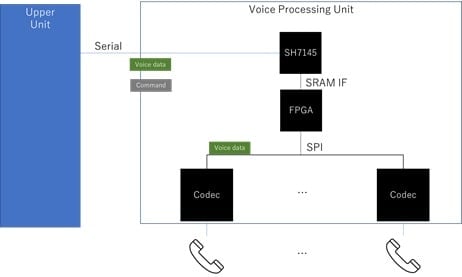Today I am reporting on the interview on reviews of RX MCUs with RX MCU user, Mr. Yamasaki in HITACHI Solutions Technology.
Hitachi Solutions Technology, Ltd.
System Solution Business Division
System Solution 2nd Division
Embedded Solution Design 4th Dept
Mr. Koji Yamasaki

Yamasaki:
We at HITACHI Solutions Technology have been working on embedded-related development in a wide range like industrial and consumer fields for a long time. Today, I would like to talk about the impression of RX MCUs.
In a word, RX MCUs are good microcontrollers. A good MCU means that it has specifications based on end-user applications, allowing users to easily realize what they want to do. Here is an example of the development of the voice processing unit using RX72N, which enables calling between a terminal operator and a maintainer. We used to adopt SH-2, however, this product might not extend its lineup anymore, so we have been requested to redevelop the unit.
The configuration of the unit is shown below.

At first, we had considered adopting RL78, which was more available than SH-2 and had a performance equivalent to it. Finally, we have recommended RX72N to our customer and they have decided to adopt it.
This is because our customer valued RX72N’s availability and reduction in the workload brought with it in the future.
The table below shows a comparison between SH-2 and RX72N.
Table: Comparison of Specification Between SH-2 and RX72N
| Item | SH-2 | RX72N |
|---|---|---|
| Operating Frequency | 50MHz | 240MHz |
| Memory (ROM/RAM) | 256kB/8kB | 4MB/1MB |
| Communication I/F | UART, I2C | Ether, USB, SPI, UART, I2C |
As shown in this table, RX72N has an excess specification against SH-2. Considering future enhancement of system performance and functions, RX72N’s high-speed, large-capacity flash memory and various communication I/Fs would allow for only a minor change without changing the MCU in every specification change. We have thought this would greatly reduce the workload in the future.
For example, when considering a redesign for reducing system cost, if voice processing by Codec could be replaced by RX72 software processing, it would be possible to reduce Codec. This requires not only a high-speed CPU but also a built-in flash memory that minimizes the waiting time of the CPU. The waiting time of RX72N built-in flash memory by miss hit penalty is up to 4 cycles, which fully brings out CPU performance, and we don’t go out of our way to place a code requiring high-speed processing such as cache and TCM. This is a big feature that can’t be seen in the manual. Also, with the recent trend toward IoT, as the need for communication functions like Ether and USB is growing, the code size is proportionally increasing. RX72 has a flash memory of up to 4MB, so we thought the capacity shortage would not occur for a while.
We are gradually getting requests for developing existing products toward IoT. We would appreciate if there were an IDE where we could use the actual cloud service.
Mr. Yamasaki, thank you for taking the time to join this interview.
